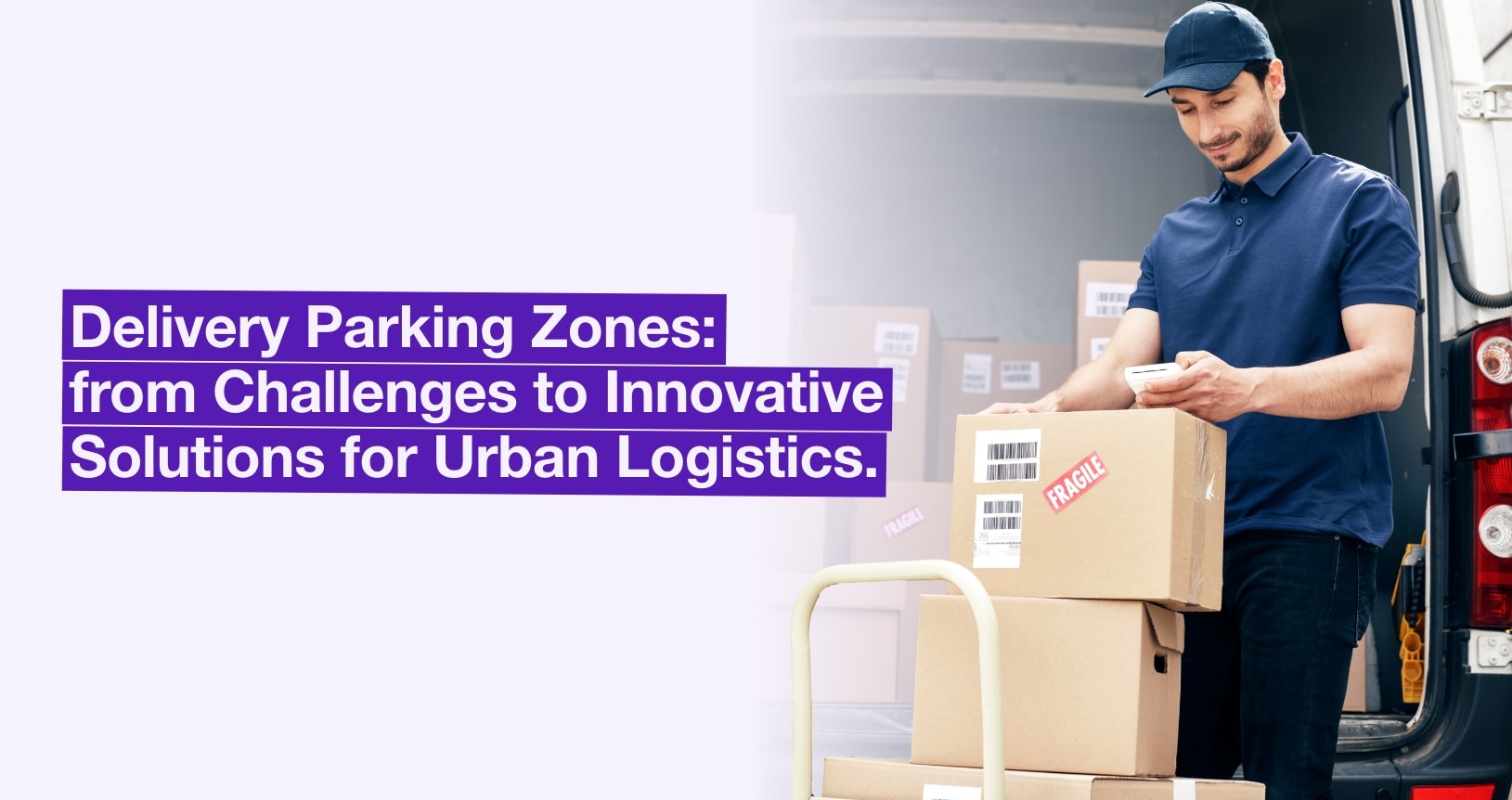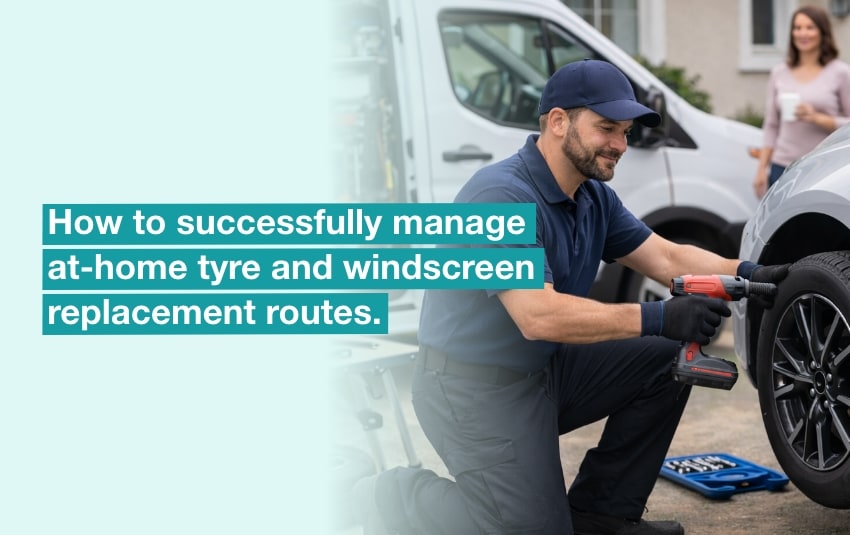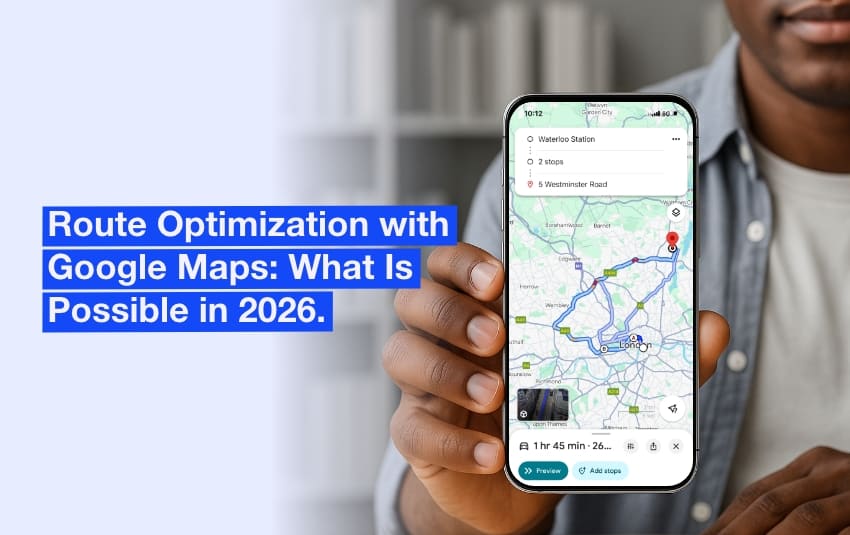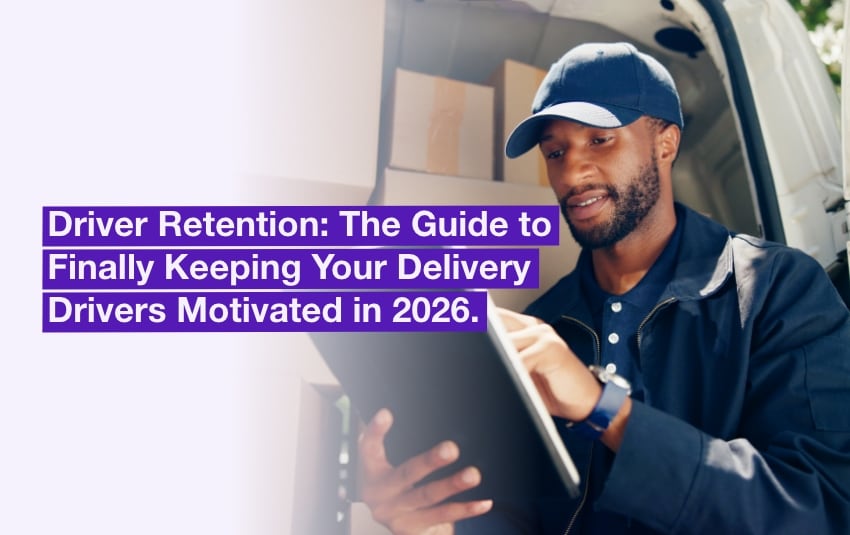Delivery Parking Zones: from Challenges to Innovative Solutions for Urban Logistics
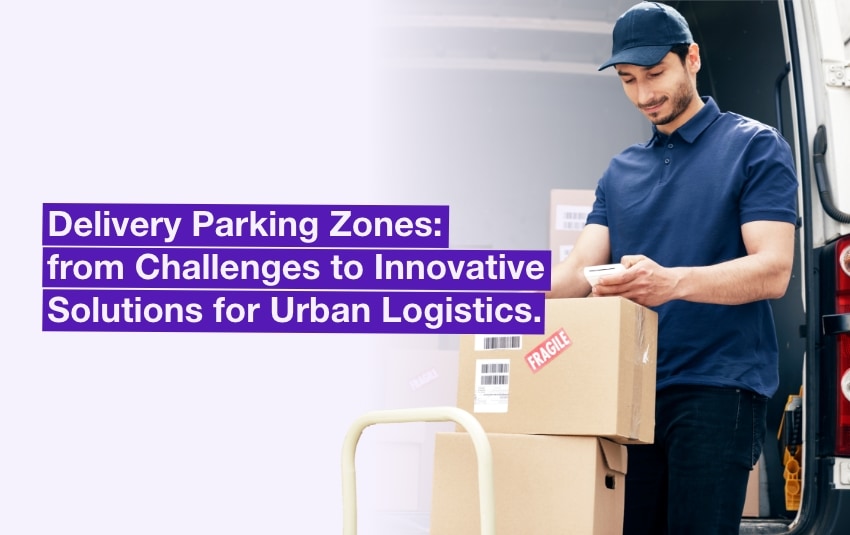
Imagine driving through the busy centre of a city. Cars, lorries and bicycles make their way through the narrow streets, while the pavements are crowded with pedestrians in a hurry. At the heart of this urban hustle and bustle are the delivery parking zones, key areas for the regular supply of goods to businesses in the town centre.
These areas are not without their challenges. Between the difficulties of siting spaces and the specific needs of delivery drivers and their vehicles, delivery parking zones encounter a series of problems that hamper their efficiency. But solutions are emerging that encourage innovation in urban logistics.
Table of contents:
- Understanding Urban Logistics
- The Challenges of Urban Delivery Parking Zones
- How to Improve Delivery Parking Zones
- Tools for Optimising Delivery Planning
In the heart of cities, delivery parking zones are revolutionising urban logistics. These dedicated spaces for delivery drivers ensure the regular supply of goods in the city.
What is a Delivery Parking Zone
In urban areas, deliveries are complicated by lack of space and heavy traffic. To make this task easier and avoid traffic jams, delivery parking zones are created.
These spaces enable delivery drivers to stop temporarily to unload their freight without obstructing traffic.However, these areas are not always well designed and are often used by other vehicles, forcing delivery drivers to double park.
Nearly 80% of deliveries in towns and cities are made under unauthorised parking conditions.
Understanding Urban Logistics
Urban logistics, also known as last-mile delivery, represents the final stage of the supply chain. It is also the most complex and the most costly. It includes all the flows of goods within agglomerations, from warehouses to shops and customers.
Its main objective is to guarantee fast, efficient deliveries, while optimising the use of available resources and reducing congestion. To find out more about the challenges of urban freight or logistics, please read our article on the subject.
The Challenges of Urban Delivery Parking Zones
There are many challenges:
- Traffic management: urban population growth is leading to an increase in the number of vehicles, extending journey times for deliveries and causing traffic jams. The transport of goods in cities accounts for 20% of urban traffic.
- Parking difficulties: finding parking spaces is difficult for delivery drivers, leading to awkward stops and hurried deliveries to the detriment of service quality. For example, in Paris, 50% of deliveries are made double-parked or in an awkward parking space, and 86% of parcels are transported by van to the recipient’s home.
- Environmental sustainability: freight transport contributes to greenhouse gas emissions in cities, mainly from commercial vehicles. This requires a review of processes for green logistics, including the possibility of loans from the UK government for the acquisition of low-emission vehicles.

The 5 solutions for improving delivery parking zones.
How to Improve Delivery Parking Zones
Freight and Servicing Action Plan in London
In the city, deliveries are essential for business but can lead to traffic jams. A scheme is being used in London to deal with this problem: the Freight and Servicing Action Plan.
The Freight and Servicing Action Plan (FSAP) is an initiative by Transport for London (TfL) aimed at improving the efficiency and sustainability of freight and servicing activities in the city. This plan is a key component of London’s broader efforts to enhance urban mobility, reduce congestion, and minimize environmental impacts.
Thanks to this scheme, the British capital can create an environment in which deliveries integrate harmoniously, contributing to a dynamic economy and efficient mobility for everyone.
Ergonomics
It is important to design parking spaces with the dimensions of delivery vehicles in mind. Many parking zones are unsuitable for vehicles carrying goods, either because they are difficult to access or because they are too small. A study carried out in Lyon, France, in 2010 revealed that only 220 of the 1,300 delivery parking spaces were actually accessible to commercial vehicles.
Working Conditions
Eliminating obstacles to handling, such as street furniture or kerbs that are too high, reduces the risk of falling and makes handling parcels and pallet trucks easier for the delivery driver.
Infrastructure Sharing
Some delivery areas are not used at certain times of the day, providing an opportunity to optimise urban space.
In Nice, France, parking in these areas is open to anyone at certain times, and in Paris, since 2010, certain delivery areas have been shared, allowing access to 7,000 parking spaces previously reserved for professionals.
Increase in Checks
Current penalties are not enough to discourage drivers from parking illegally in delivery areas. A survey carried out in Paris a few years ago revealed that these spaces were occupied by delivery vehicles only 6% of the time, while they were illegally occupied 47% of the time, with a penalty rate of only 1%.
Some cities are planning to reinforce monitoring by using post-parking or post-stop fee, which would be a greater deterrent effect than the current fines.
Parking sensors could also be used to improve monitoring.

Delivery parking zones ensure the supply of goods to businesses in the city.
Tools for Optimising Delivery Planning
Measures have been implemented to improve traffic flow and limit the improper use of delivery parking zones. Here are a few strategies and best practices to consider in order to optimise the planning of these operations:
1. Open data
European cities are offering open data on delivery parking zones as part of their commitment to transparency. This includes information such as geographical location, operating hours, restrictions and regulations, and usage statistics.
This open data can be integrated into driving assistance tools, via an application such as AntsRoute, to optimise delivery operations, improve urban planning and facilitate traffic management.
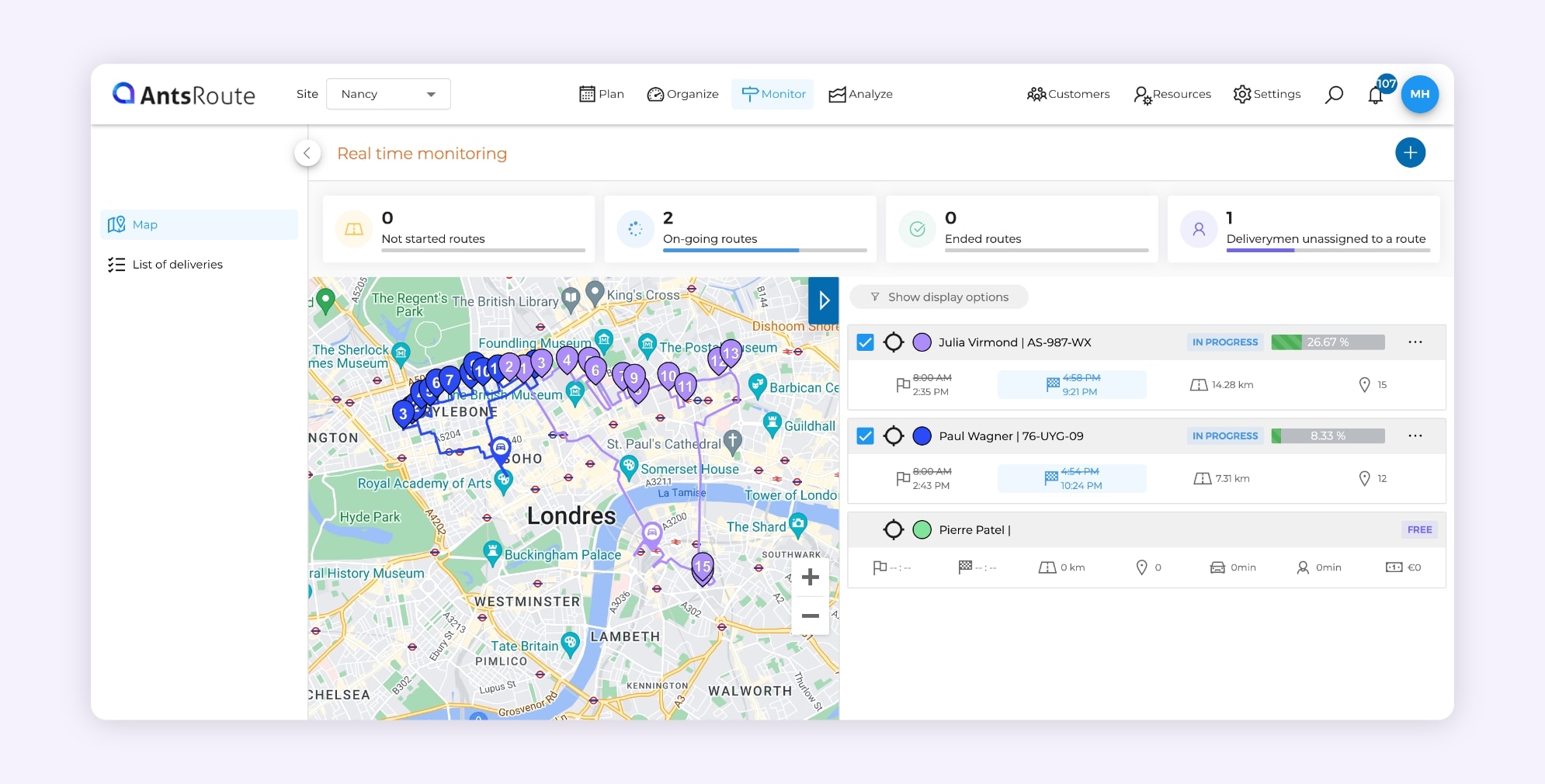
AntsRoute delivery route optimisation software.
2. Optimising Parking Time with a Delivery Disc
Some cities use discs to regulate parking in delivery spaces and facilitate vehicle turnover. Of course, this rule does not apply to private individuals.
The parking time is generally set at 30 minutes to allow goods to be loaded or unloaded. The driver simply indicates the time of arrival on the disc.
In Grenoble, France, the limit is 20 minutes, while in the Lyon agglomeration it is 30 minutes. In Nantes, two types of disc are used: green for clean vehicles and pink for others. This distinction makes it possible to adapt the use of delivery parking zones according to the type of engine used, with a longer time slot for low-emission vehicles. The scheme aims to reduce CO2 emissions, support trade, improve traffic flow and improve working conditions for delivery drivers.

Regulate parking in delivery zones and facilitate vehicle turnover.
3. Integrating Sensors
Some local authorities are using sensors in delivery parking zones to optimise parking, improve availability and facilitate urban logistics management.
These sensors have several functions: indicating the remaining parking time, providing information on the occupation of the delivery space, and transmitting data to the authorities.
In London, Smart Parking Sensors have been installed, especially in the Westminster district. The aim is to send drivers information about free parking spaces via a mobile application.
The sensors are installed under parking spaces and are able to detect whether or not a vehicle is parked there.
The project uses open data from the city council, local authorities and private companies and combines it with Open Street Maps.
4. Applications for Smart Management of Delivery Parking Zones
With these applications, you are entering the era of sustainable urban logistics and digitalization. Their main objective is to support the ecological transition by facilitating the management of delivery parking zones.
Parkunload
This application uses Bluetooth sensors to simplify the management of delivery parking zones. It detects your parking permit and tells you the maximum time allowed in your area. In just 3 seconds, you can start a parking situation and receive real-time information about available parking spaces nearby. Parkunload helps to increase vehicle turnover, freeing up spaces to facilitate urban freight. Stuttgart in Germany and several towns in Spain are using this application.
Parkingmap
This application provides users with real-time information on available parking spaces and uses sensors to determine occupancy. It enables local authorities to analyse traffic flows and adapt their offer. Used by private companies such as Carrefour and by local authorities such as Paris, Parkingmap offers an effective solution for parking management.
Delivery Park in France
Developed by InTerLUD in France, Delivery Park is a digital alternative to the parking disc. Tested in Greater Lyon, it uses real-time data to track goods movements and locate existing delivery parking zones.
SPRO in Barcelona
Most delivery parking zones in Barcelona are connected to the SPRO app. Drivers must register their stop via a mobile application, a text message or a parking meter. This system allows around 100,000 professionals to park for free for 30 minutes, with an extra 30 minutes for zero-emission vehicles. Nearly 96% of registrations are made via the app. Some 40,000 operations are recorded every day, according to Barcelona de Serveis Municipals.
5. Alternative Delivery Method: the Cargo Bike
In January 2021, Lyon, France, launched its first delivery parking zone reserved exclusively for cargo bikes. This area, regulated by a municipal by-law, is strictly dedicated to cycle-logistics, prohibiting motorised vehicles from stopping or parking. The maximum stopping time for loading and unloading operations is 15 minutes, to ensure an efficient flow of deliveries.
In London, Amazon has launched its first UK delivery hub with a fleet of electric cargo bikes set to complete last-mile deliveries in central London.
To try our route management software for 7 days, simply register here. The trial is free and without commitment.
WRITTEN BY
Florine Martin
Florine has been a freelance web copywriter since 2021, writing for a variety of clients in a range of sectors. Since the beginning of 2024, she has been writing articles about logistics for our company, AntsRoute.
Free 7-day trial | No credit card required
Contenu
- What is a Delivery Parking Zone
- Understanding Urban Logistics
- The Challenges of Urban Delivery Parking Zones
- How to Improve Delivery Parking Zones
- Freight and Servicing Action Plan in London
- Ergonomics
- Working Conditions
- Infrastructure Sharing
- Increase in Checks
- Tools for Optimising Delivery Planning
- 1. Open data
- 2. Optimising Parking Time with a Delivery Disc
- 3. Integrating Sensors
- 4. Applications for Smart Management of Delivery Parking Zones
- 5. Alternative Delivery Method: the Cargo Bike


